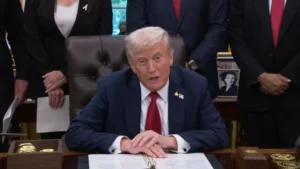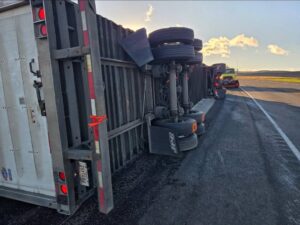WASHINGTON — Trucking officials and state business leaders alike applauded the March 10 reintroduction of the DRIVE-Safe Act by U.S. Sens. Todd Young (R-Ind.) and Jon Tester (D-Mont.). The bill establishes an apprenticeship program allowing CDL holders under the age of 21 to legally operate commercial motor vehicles in interstate commerce.
Currently 49 states and the District of Columbia allow individuals to obtain a CDL between the ages of 18 to 20; however federal law prohibits them from moving goods across state lines.
“Today, 18-year-olds can drive more than 200 miles from New Albany, Indiana, to Gary, Indiana, and back, but they aren’t allowed to drive 2 miles from New Albany to Louisville, Kentucky,” Young said in a press release. “The DRIVE-Safe Act will eliminate this ridiculous regulation, and in doing so, address the driver shortage while providing new career opportunities for young Hoosiers.”
Officially titled the Developing Responsible Individuals for a Vibrant Economy Act, the proposal is designed to help train tomorrow’s drivers well above current standards. Under the proposed legislation, when a driver meets the requirements to obtain a CDL, they will begin a two-step program of additional training, which includes rigorous performance benchmarks. The program requires these drivers to complete at least 400 hours of on-duty time and 240 hours of driving time with an experienced driver in the cab.
In addition, all trucks used for training in the program must be equipped with safety technology, including active braking collision-mitigation systems, video event capture, and a speed governor set at 65 mph or less.
The bill looks to address, in part, the truck driver shortage that has already reached critical proportions nationally. Fox Business reported in April that at the end of 2018, there was a shortfall of some 60,000 drivers, and the problem has only gotten worse. CNN Business reported May 1 that one-fifth to one-quarter of tank trucks will remain parked this summer, raising concerns over gas shortages at the pump. And that’s just the tip of the iceberg — 71% of all freight in the U.S. is moved by trucks.
Given all of that, the bill has strong support from a coalition of industry types, including the Next Generation in Trucking Association, a nonprofit that engages and trains the next generation of trucking industry professionals; the International Foodservice Distributors Association; and the American Trucking Associations (ATA).
“We are pleased to see the DRIVE-Safe Act be reintroduced in the Senate. The bill has strong bipartisan support because it is a pro-safety, common-sense solution to expanding the pool of potential truck drivers. It raises the bar for training standards and safety technology far above what is asked of the thousands of under-21 qualified drivers who are already legally driving commercial vehicles in 49 states today, and requires more training than currently required for drivers over 21 as well,” said Sean McNally, spokesman for ATA.
“The DRIVE-Safe Act is not a path to allow every young person to drive across state lines, but it envisions creating a safety-centered process for identifying, training and empowering the safest, most responsible 18- to 20-year-olds to more fully participate in our industry. It will create enormous opportunities for countless Americans seeking a high-paying profession without the debt burden that comes with a four-year degree,” he continued.
Many general business associations across the country also threw their support behind the proposed legislation, roundly calling for swift passage of the new law.
“We are wildly in favor of this,” said Gary Langston, president and CEO of the Indiana Motor Truck Association. “Not just in Indiana, but across the nation (the driver shortage) is the No. 1 concern for the trucking industry. So, anything that will improve productivity, improve efficiency or improve the market for additional drivers is going to help the entire industry.”
The bill quickly attracted the support of several other legislators, including U.S. Sens. Tom Cotton (R-Ark.), Jim Inhofe (R-Okla.), Angus King (I-Maine), Joe Manchin (D-W.V.), Jerry Moran (R-Kan.) and Kyrsten Sinema (D-Ariz.), who all joined as original cosponsors of the bill. U.S. Rep. Trey Hollingsworth (R-Ind.) introduced a companion bill in the House.
“I’m extremely pleased that Sen. Manchin has put his name and support and the clout that brings behind this piece of proposed legislation,” said Steve Roberts, president of the West Virginia Chamber of Commerce. “We need this bill. It would have an impact on us in West Virginia; it would have an impact in a very positive way. I just can’t think of a way that we could be anything but very supportive and very appreciative of the members of the Senate and the House who are behind this kind of legislation.”
Roberts said examples abound of lost business opportunities and economic activity to states due to the lack of qualified drivers.
“Just last week a very large firm with international connections contacted me and said they had a profitable piece of business for a trucking company and they would like to share that business with a company headquartered in West Virginia,” he said. “I called around and talked to, in particular, the company that is the largest, most prominent in West Virginia and they simply said, ‘We’d like to have the business, but we don’t have the workforce. We don’t have the drivers.’
“It wasn’t one of those, ‘Let us think about it,’ or ‘Let me see what we can do.’ It was a very direct, ‘We know we can’t take this on,’” Roberts noted.
Randy Zook, president and CEO of the Arkansas State Chamber of Commerce, concurred, saying having sufficient truck drivers is critical for moving that state’s economy forward.
“Anything that would improve the chance of recruiting truck drivers would be a step forward in the economy, because it’s one of the critical pinch points in achieving the kind of growth we all want to see,” Zook said. “The fact is, there tends to be pretty high turnover, and trucking companies have a difficult time keeping those jobs filled and keeping those trucks rolling. Whatever this would do to help that would be a step in the right direction.”
Asked about the safety issues involved in putting several tons of machinery, moving at high speed, in the hands of an 18-year-old, Zook reiterated the training protocols the bill calls for. He also pointed to numerous other professions where much is asked of people right out of high school.
“We let those 18-year-olds or 19-year-olds go to war for us, with dangerous equipment,” Zook said. “So, the right 18-year-olds and 19-year-olds could handle this job perfectly safely if they are trained well, as they are by the industry.”
As for implementation of the bill upon passage, many state associations have already formed the kinds of partnerships that would allow younger drivers to get into the education pipeline quickly. However, as Langston admits, this is not without its challenges.
“We worked aggressively in an effort to try to get vocational programs in high schools where, when someone comes out of high school at 18 years old, they’re already ahead of the game and have already had some training. We continue to work on that in an effort to be prepared,” Langston said.
“Yes, it would require some change because it requires more training than the regular CDL driver who’s above 21 would receive,” he continued. “Not every truck on the road today has all of the most advanced technology, either. So yes, it would require some changes.”
However, such problems are ones the business community in general — and the transportation industry in specific — would love to have. And, Young predicts, that’s exactly what they are going to get.
“The response and feedback have been great,” Young said. “Last Congress, the bill garnered 35 co-sponsors, and in this Congress, we are adding new co-sponsors every week. My expectation is that the DRIVE-Safe Act will either pass on its own or align with other safety priorities for inclusion in a surface transportation reauthorization bill this year.”
Words like these are music to the ears of people like Roberts, who says his state is at the ready to make the most of the DRIVE-Safe Act, once ratified.
“We would be immediately involved,” Roberts said. “We have a program that we sponsor called Jobs for West Virginia’s Graduates; this is a program where we try to take high school juniors and seniors and get them onto a career path. Typically, the students we’re working with are not college-bound and who are (the ones) most in need of career guidance and a mentor and help getting through the high school curriculum.
“We would immediately take the opportunity for employment to those schools that are involved with Jobs for West Virginia’s Graduates,” Roberts continued. “We would also reach out to the community and technical colleges and to the high school career centers to involve them, because these are the kinds of jobs that are career jobs families can live on. Our state and our nation desperately need these employees to come into the workforce.”
Dwain Hebda is a freelance journalist, author, editor and storyteller in Little Rock, Arkansas. In addition to The Trucker, his work appears in more than 35 publications across multiple states each year. Hebda’s writing has been awarded by the Society of Professional Journalists and a Finalist in Best Of Arkansas rankings by AY Magazine. He is president of Ya!Mule Wordsmiths, which provides editorial services to publications and companies.















